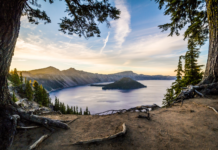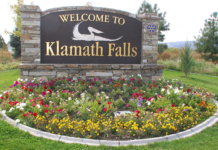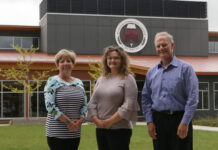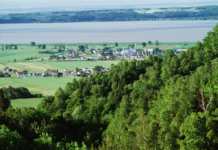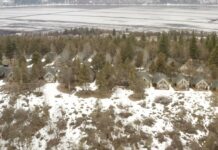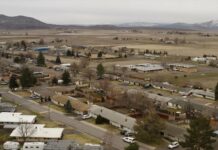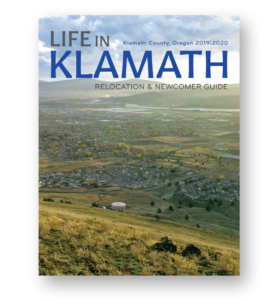The Melting Pot
The Klamath that we know today is actually a melding of several different communities that sprung up around the waters of an enormous glacial basin. Linkville, situated on the Link River that connects Lake Ewauna to Upper Klamath Lake, was renamed Klamath Falls in 1893, and has evolved into the City of Klamath Falls, with a population of over 40,000 people. The many natural wonders found in Klamath also attract tourists and recreational visitors to the county. There is currently a tourism boon in the area; visitors are beginning to discover the rare natural wonders that the locals have known about for years.

Breathe Easy
Oddly enough Klamath used to be known to a different sort of tourist – those with respiratory issues. The high elevation and dry air regionally was attractive for asthmatics and those with tuberculosis from around the world. The old sanitorium has been closed for decades, but residents with respiratory issues can still breathe a sigh of relief in Klamath’s fresh, dry mountain air.
The Birth of Klamath
By 1843 the westward migration on the Oregon Trail was reaching a climax, which presented prime opportunity for settlement in the Klamath Basin to begin. In 1867 George Nurse founded a town at the mouth of the Link River – a 1.5-mile finger that cuts through the mountainous terrain to connect two enormous bodies of water: Upper Klamath Lake (with a surface area of 96 square miles) and Lake Ewauna. The town of Linkville was formed at the mouth of the Link River. In 1893 the name was changed to the town of Klamath Falls, which would eventually be incorporated as the City of Klamath Falls by the state legislature in 1905. When the Legislative Assembly created Klamath County in 1882, it designated Linkville as the county seat, although it gave the voters the chance to select another site during the 1884 general election. Also in 1905 the federal government announced it would fund construction of the Klamath Reclamation Project, which became operational by 1906.
Rural Roots – Industrious Branches
Klamath Falls was known for its forests and rangeland, but the region was far too remote from major markets to make money. In 1909 the Southern Pacific Railroad arrived in Klamath Falls, and subsequently the money came rolling in. In the 1920s Klamath Falls was the fastest growing city in Oregon, until the Great Depression of 1929 brought the lumber boom to an end. Historically Klamath County’s economy has been based on timber and agriculture. Three-fourths of the county is forested; however, over half is publicly owned. The large stands of timber resulted in the development of wood product industries in the county. Agriculture also played an important role in the economy. Excellent soil, plentiful water for irrigation, and extensive sunshine led to the introduction of cash crops such as potatoes and feed barley, contributing to the agricultural industry.
Native History

Klamath was named for one of the three Native American tribes that lived in the Klamath Basin from time beyond memory. While the first encounters between native peoples and the subsequent influx of traders and trappers were mostly friendly, conflict arose over competition for the resources and ideal trading locations. As was tragically and regrettably too often the case, this led to a forced displacement of these native tribes and a succession of wars ensued. These events included the Modoc War, which received a good deal of national attention in the 1870s. Skirmishes between the Klamath and Modoc Indians at the northern end of the Klamath Basin compelled a band of Modoc (led by Captain Jack) to leave for their traditional lands on the southern end, and when the U.S. Army attempted to forcibly remove the band back to the northern reservation, multiple battles ensued. These included the battles of Captain Jack’s Stronghold, a formidable lava rock fortress with many caves and grottos, where the U.S. Army incurred heavy losses.
Volcanic Legacy
The volcanic legacy that was once the stage of such tragedy is now being used for the benefit of all Klamath County residents. Klamath is one of the nation’s leaders in geothermal energy. Newcomers are often surprised on morning commutes to see columns of warm steam gently rising from storm drains on many of Klamath’s streets. These little ground clouds are a result of the naturally occurring superheated water that lies just beneath the surface of much of Klamath Falls. Many buildings in the area use this abundant and free renewable energy for their HVAC and power needs; including heated sidewalks, which are commonly implemented throughout the downtown Klamath Falls area. Due in part to its access to Klamath’s hotbed of geothermal activity, Oregon Institute of Technology created the first Renewable Energy Engineering Program in North America.
Energetic Future
Klamath’s resource rich legacy is set to continue into the future as it positions itself to become a power supply depot for its consumer customers to the south. Already equipped with transmission infrastructure connecting it to Californian markets, the Klamath energy corridor has numerous active generation projects as well as ones in various stages of implementation. These include natural gas cogeneration (active), solar (active), hydroelectric generation (active), geothermal electric (active), hydroelectric storage facility (proposed), biomass conversion (proposed), and wind turbine (small scale-active). Power generation isn’t the only novel industry for which Klamath is primely positioned.
Healthy Future
Healthcare is also set for a big future. Several of the local higher education systems have renowned training in areas such as nuclear medicine, nursing, dental hygiene, Pre-med, lab sciences, radiologic sciences, respiratory care and vascular technology – many of these partnering with Sky Lakes Medical Center for field specific, real world training. Additionally, the Medical Center Complex, in partnership with OHSU, includes Cascades East – a clinician residency training program that specializes in rural family medicine. Cascades East residents are required to do rotations at rural clinics across the state, bolstering their ability for “frontier medicine.”
Military Partnership
Maintaining the continuity of community partnerships that is found with ubiquity in the Klamath Basin, the city recently demonstrated its unparalleled support to the 173rd Fighter Wing, by extending the lease on the airfield property to 2095 – making it the Air Force’s longest lease. On top of recent base improvements and personnel expansions, this new lease also increases the base’s usable airspace, making the already world renowned F-15 training facility now also the nation’s largest flight theater at 11,300 square miles. Whatever the future holds for lives of Klamath Falls residents, they are sure to be living with the relaxed contentment of being in this mountain paradise, “Where Mountain Meets Desert,” and abundant waters flow. Residents have often relished an idea that, whatever activity their passion for life draws them towards, they can usually get their fill in the evening after work thanks to the proximity of things to do –and the lack of traffic in getting there


